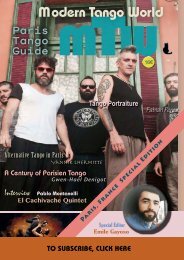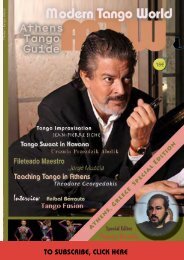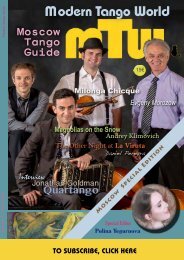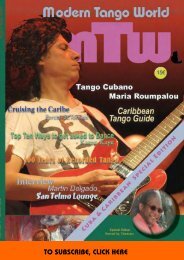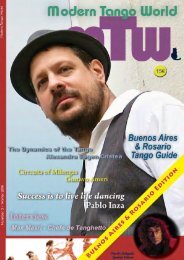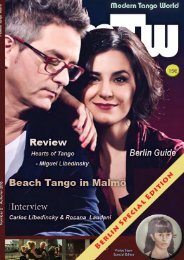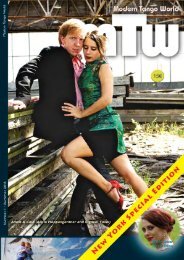Modern Tango World #9 (Rome, Italy)
Rome Special Features Symbolic Roman Tango Places Mario Abbati 03 Milongas in Rome Enrico Colagrossi 08 Roman Tango, 1980 to Present Emanuela (Mela) Molinari 13 Roman Road to NeoTango Elio Astor 16 Guide to Tango in Rome 20 Endless Tango William Hudson Temples 26 Interview with Mariano Mattone (Tangothic) Raymond Lauzzana 30 Visual dancing Andreas Lange 33 From León to Patagonia and Back Eduardo Delgado Hernández 36 New Tango Music Arndt Büssing 40 Tango Moves: Ochos (Figure Eights) Raymond Lauzzana 44
Rome Special Features
Symbolic Roman Tango Places Mario Abbati 03
Milongas in Rome Enrico Colagrossi 08
Roman Tango, 1980 to Present Emanuela (Mela) Molinari 13
Roman Road to NeoTango Elio Astor 16
Guide to Tango in Rome 20
Endless Tango William Hudson Temples 26
Interview with Mariano Mattone (Tangothic) Raymond Lauzzana 30
Visual dancing Andreas Lange 33
From León to Patagonia and Back Eduardo Delgado Hernández 36
New Tango Music Arndt Büssing 40
Tango Moves: Ochos (Figure Eights) Raymond Lauzzana 44
You also want an ePaper? Increase the reach of your titles
YUMPU automatically turns print PDFs into web optimized ePapers that Google loves.
My current compositions consist of six layers. These are<br />
super-imposed layers that can be mixed together in a<br />
variety of ways. I use 18 decks of different raw materials<br />
that I change between. To animate the visuals, I use 123<br />
effects organized in 22 groups. With one button of one<br />
of the midi controllers, I can simultaneously switch multiple<br />
effects on or off. Some parameters of the effects<br />
are coupled to the beat, while others set manually thru<br />
the midi controllers.<br />
The signal for the beat can be taken directly from the<br />
computer playing the music to the computer running<br />
the visuals. I prefer synchronizing the beat myself with<br />
a button on the midi-controller. I can I set the effect<br />
parameters on the full beat, and on every second beat<br />
or on a quarter beat. Sounds complicated at first, but it<br />
gives you the possibility to fully concentrate on the music.<br />
A sketch of the button layout can help remembering<br />
the functions.<br />
For me. music consists of three main aspects — the<br />
rhythm, the melody and the mood it creates. I use these<br />
attributes in dancing, emphasizing them in different ways<br />
during a song. This is also the way I perform the visuals<br />
to the music. In other words, I am dancing to the music<br />
with the visuals. The mutual interaction between dancers<br />
and DJ is thereby enhanced with this visuals element.<br />
This additional dimension offers the dancers yet another<br />
way to gain access to the whole depth of the music.<br />
What needs to be taken into consideration to achieve this<br />
effect? What is happening to us when we not only hear<br />
music, but we let ourselves be touched by it? What is music?<br />
Is it a rhythmical sequence of sounds? No.<br />
The composer and the musicians are creating music with<br />
their entire souls. Through the creative depth of their<br />
works, our innermost emotions and experiences can<br />
be addressed. If we give ourselves over to this without<br />
hesitation, we become totally immerge in the music. Our<br />
desires and our limits are being touched.<br />
How is this immersion and being touched expressed in<br />
dance? If we restrict ourselves to excecuting contrived<br />
sequences of steps that match the rhythm, then we stay<br />
at the surface of the music and hide our innermost selves.<br />
When we create movements inbetween the steps, we<br />
change the dynamics, and become freely ourselves —<br />
absolutely in the moment. If we let the music touch us<br />
without inhibitions and become drenched with the music,<br />
we fully give ourselves over to our dance partner and<br />
we experience a shared journey through something that<br />
touches all humans. Therefore, we have the possibility to<br />
experience deepest joy, as well as we have the chance to<br />
touch our own wounds in a healing way. To accompany<br />
this journey and to experience it myself, for me is the<br />
art of VJing. It is opening yourself to the music and the<br />
dancers. This accompaniment offers the dancers a visual<br />
surrounding that encourages their immersion into the<br />
emontional level of the music.<br />
During the last two years, I have spent ten to fifteen hours<br />
per week creating visual material, processing it and generating<br />
compositions. I have had numerous performances<br />
at neotango events and electronic music, as well classical<br />
music events. I especially like it, when musical pieces<br />
are being merged, in the way Elio Astor, tango DJ from<br />
<strong>Rome</strong>, has introduced it to neotango. This way there is no<br />
break inbetween pieces but an exciting change.<br />
In order to have even more freedom whilst performing,<br />
I continue to work on new visual content. Sometimes<br />
I split videos into individual frames, modify the frames<br />
with complex Photoshop Actions and splice them back<br />
together again as videos. For the future I am planning to<br />
program my own video effects.<br />
See: http://www.youtube.com/alvisualisierung<br />
— 37 —photo by Reiner Akermann<br />
TO SUBSCRIBE, CLICK HERE




